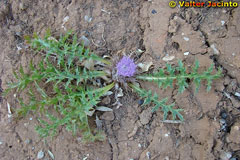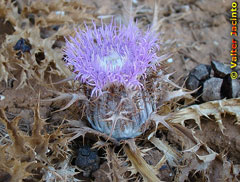 |
|
http://flickr.com/photos/58213213@N00 |
 |
| http://flickr.com/photos/58213213@N00 |
Translate this page:
Summary
Physical Characteristics

 Atractylis gummifera is a PERENNIAL growing to 0.6 m (2ft).
Atractylis gummifera is a PERENNIAL growing to 0.6 m (2ft).
See above for USDA hardiness. It is hardy to UK zone 6. The species is hermaphrodite (has both male and female organs).
Suitable for: light (sandy), medium (loamy) and heavy (clay) soils. Suitable pH: mildly acid, neutral and basic (mildly alkaline) soils. It can grow in semi-shade (light woodland) or no shade. It prefers moist soil.
UK Hardiness Map
US Hardiness Map
Synonyms
Plant Habitats
Cultivated Beds;
Edible Uses
Edible Parts:
Edible Uses: Gum Gum
A gum obtained from the plant is used for chewing[46, 61, 100].
References More on Edible Uses
Medicinal Uses
Plants For A Future can not take any responsibility for any adverse effects from the use of plants. Always seek advice from a professional before using a plant medicinally.
None known
References More on Medicinal Uses
The Bookshop: Edible Plant Books
Our Latest books on Perennial Plants For Food Forests and Permaculture Gardens in paperback or digital formats.

Edible Tropical Plants
Food Forest Plants for Hotter Conditions: 250+ Plants For Tropical Food Forests & Permaculture Gardens.
More

Edible Temperate Plants
Plants for Your Food Forest: 500 Plants for Temperate Food Forests & Permaculture Gardens.
More

More Books
PFAF have eight books available in paperback and digital formats. Browse the shop for more information.
Shop Now
Other Uses
Gum Gum
A gum obtained from the plant is used as an adulteration for mastic[46, 61, 100]. Mastic (obtained from Pistacia lentiscus) is used in high grade varnishes, as a fixative in perfumes, tooth pastes, glue (especially for false beards), embalming, a temporary filling for teeth etc[7, 11, 46, 57, 64, 171, 200, 238]. It is used to seal the edges of microscope mounts and is also chewed to preserve the teeth and gums[64].
Special Uses
References More on Other Uses
Cultivation details
We have very little information on the cultivation needs of this species, but it succeeds outdoors at Bristol Botanical Gardens, where it flowers and sets viable seed[K]. It is likely to prefer a well-drained soil and a sunny position[K]. It strongly dislikes winter wet[K]. A monocarpic plant, living for a number of years without flowering, but then dying after it does flower.
References Carbon Farming Information and Carbon Sequestration Information
Temperature Converter
Type a value in the Celsius field to convert the value to Fahrenheit:
Fahrenheit:
The PFAF Bookshop
Plants For A Future have a number of books available in paperback and digital form. Book titles include Edible Plants, Edible Perennials, Edible Trees,Edible Shrubs, Woodland Gardening, and Temperate Food Forest Plants. Our new book is Food Forest Plants For Hotter Conditions (Tropical and Sub-Tropical).
Shop Now
Plant Propagation
Seed - sow early spring in a greenhouse or cold frame. When large enough to handle, prick out the seedlings into individual pots and grow them on in the cold frame until they are planted out in early summer. Alternatively, the seed can be sown in situ in mid to late spring.
Other Names
If available other names are mentioned here
Native Range
TEMPERATE ASIA: Turkey (west) EUROPE: Greece (incl. Crete), Italy (incl. Sardinia, Sicily), Spain, Portugal AFRICA: Algeria, Morocco, Tunisia
Weed Potential
Right plant wrong place. We are currently updating this section.
Please note that a plant may be invasive in one area but may not in your area so it's worth checking.
Conservation Status
IUCN Red List of Threatened Plants Status :

Growth: S = slow M = medium F = fast. Soil: L = light (sandy) M = medium H = heavy (clay). pH: A = acid N = neutral B = basic (alkaline). Shade: F = full shade S = semi-shade N = no shade. Moisture: D = dry M = Moist We = wet Wa = water.
Now available:
Food Forest Plants for Mediterranean Conditions
350+ Perennial Plants For Mediterranean and Drier Food Forests and Permaculture Gardens.
[Paperback and eBook]
This is the third in Plants For A Future's series of plant guides for food forests tailored to
specific climate zones. Following volumes on temperate and tropical ecosystems, this book focuses
on species suited to Mediterranean conditions—regions with hot, dry summers and cool, wet winters,
often facing the added challenge of climate change.
Read More
Expert comment
Author
L.
Botanical References
89
Links / References
For a list of references used on this page please go here
Readers comment